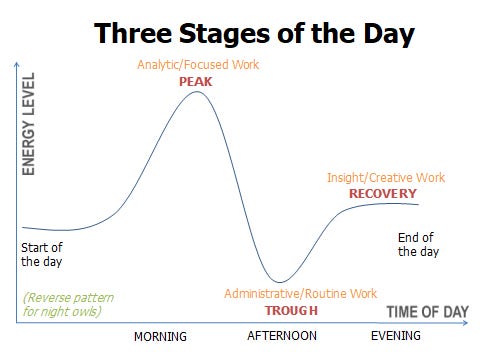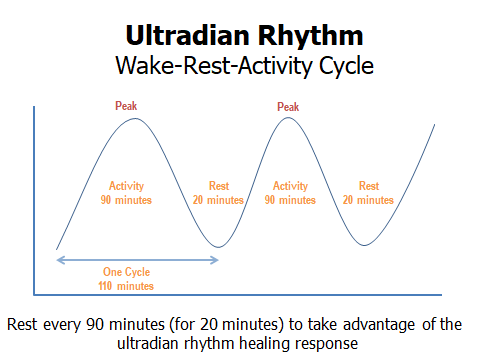5.3. 4 Tools To Become a More Productive Leader
4 Tools To Motivate YourSelf and Create Your Future
What You'll Learn:
💡 How to overcome productivity roadblocks and maintain work-life balance.
💡 Ways to lead by example while delegating effectively.
💡 4 practical tools to boost your productivity while managing energy.
From A Break to Productive
In my team at Amazon, we used to say: “The most stressful periods of the year are October to November and February to March”. In October-November due to reInvent and in February-March due to planning/scoping work. You can correlate those months with my publication dates. In the last 3 weeks, I had to prepare the review of a 5 Customer Questions Working Backwards document with senior leaders in an onsite, and an internal AWS conference presentation. But there was something else: 2 children in Daycare + Winter Flu. We have been rotating the flu at home over the last 2 months.
The result? At work great, but I slowed down and got delayed in our 30 Days Thriving Challenge. Publishing daily in the chat and 2 weekly posts, together with the stress at work and sickness at home, was too much. I needed to rest. I needed to take breaks. Taking breaks helps us to refresh our minds and to refocus later. To be resilient. But we need to get up, and productivity tools can help us to get back on track.
Today, I share with you the 4 productivity tools that I promised you in my last post. Next,
and will publish guest posts on Earn Trust.Productivity vs Motivation
Productivity isn't just about getting things done. It's about effectiveness (doing the right things, the appropriate goals, and quality of work) and efficiency (doing things right and quantity of work).
While motivation drives our intensity and persistence, being motivated makes us 17% more productive. However, we often fall into productivity traps.
Common Productivity Roadblocks
Firefighting: Spending time on urgent issues that need resolution, rather than progress on more important and impactful goals. Example: Solving all oncall tickets instead of planning, executing, and tracking by severity.
Lack of Clarity: Ambiguity about how to move a project forward or what to work on. Lack of deadlines, importance unawareness, or what needs to get done. Example: Early this year my team was blocked by high level leadership decisions. It impacted the productivity of the team.
Cherry picking: Choosing what to do to make quick accomplishments and feel productive instead of focusing on what’s important. Example: Talking with stakeholders without an intentional plan.
Lack of Planning: Spending a disproportionate amount of time on activities and projects that are not important nor add value. Example: Working on projects that are not aligned with your leadership.
Distractions: External and internal interruptions that keep you from giving something your full attention. Example: Opening new browser tabs while switching to a different, slightly related topic.
Lack of Focus: Diminished concentration that slows down your progress and makes a task bigger in time. Example: Rereading a document or email.
To avoid getting trapped, we need to be aware of the productivity roadblocks and find a balance.
Avoiding Productivity Roadblocks as Leaders
As leaders, we need to lead by example as well as delegate while avoiding the productivity roadblocks. When something is urgent but not important to you, that usually means it is urgent and important to somebody else. But as we work in collaborative settings, sometimes we need to complete tasks that are sand instead of big rocks (unimportant tasks). Not collaborating enough can impact your ability to Build Trust and not working on your important projects can impact your ability to Deliver Results. We need a balance.
Great leaders are self-aware and adaptable. Here’s how to lead with balance:
Know Your Why: Before stepping into a task or delegating, ask yourself; Why am I choosing this approach? Acting with intention ensures your actions align with your goals, values, and avoids you from firefighting, lacking clarity, or cherry-picking by default.
Plan Your Tasks and Energy: Once you know your why, block time in your calendar for planning or addressing the task considering your energy and scheduled breaks. Calendarizing allows you to focus on the right things and avoid distractions, because during the autopilot while executing, we will be able to do the right things planned efficiently.
Communicate Clearly: Authentic leaders bring their team along on the journey. If you’re leading by example, explain why it’s necessary. When delegating, articulate your trust and expectations clearly. By communicating clearly, you bring clarity and focus to the team.
Adapt to the Situation: Leadership isn’t one-size-fits-all. During high-pressure moments, lead by example to inspire. In everyday operations, delegate to empower. Flexibility is key. Through daily, weekly, and monthly reviews, you will get more self-aware and be able to identify a lack of focus or planning.
Show Gratitude: Practicing gratitude helps team members feel valued and appreciated, increasing their job satisfaction and productivity. Additionally, it will boost your positivity and motivation.
4 Tools for Productive Leadership
As leaders, we can make things happen that weren’t going to happen without us. We create a vision and strategy through goals. These tips will help achieve them productively:
1. Manage Your Energy for Optimal Achievement
Understanding and managing your energy levels is crucial for peak performance. Here's how:
Identify your Chronotype: Take this quizz and determine whether you're a Lark (morning person), Third Bird (in-between), or Owl (evening person) to understand your energy peaks.
Estimate your tasks based on your energy: Assess your energy level and focus relative to the task. Estimate task duration based on your current energy state.
Organize tasks based on your energy stages: Divide your day into peak, trough, and recovery stages, and plan tasks accordingly.
"I do my high-IQ meetings before lunch. Like anything that's going to be really mentally challenging, that's a 10 o'clock meeting. By 5pm, I'm like, I can't think about that today. Let's try this again tomorrow at 10 am." — Jeff Bezos
The 3 Energy Stages
Peak: Highly vigilant, in the best mood, and with the most energy.
Trough: Major drop in mood and performance.
Recovery: Rise in mood but no great vigilance.
Night Owls, experience a reverse pattern and are in Recovery in the morning, Trough in the early-to-mid-afternoon, and Peak in the late afternoon and into the evening.
Use your peak period to focus on deep, important work and analytic, cognitively-demanding tasks. Avoid administrative work, like processing emails, and time-wasters like reading online news, at peak hours or recovery stages of the day. When you’re in your recovery period, switch to insight, creativity-driven tasks because you will be less vigilant but in a good mood.
Example: As a leader at Amazon I sometimes have to wear many hats. With the experience I identified that at my Trough stage I feel better doing TPM work than tech designs. Because I don’t need to put a lot of energy and my brain doesn’t try to avoid it. When I tried to be creative or write a tech design in the afternoon (my trough), it resulted in me wasting time and working extra hours that day.
2. Refocus by Slowing Down and Resting
Make real breaks that allow you to refresh your mind, detach from work, and help you to refocus later.
2.1. Mental Rest: Take strategic breaks of up to 20min every 90min of work to take advantage of the daily ultradian rhythm. The ultradian rhythm is the wake-rest-activity cycle that repeats through the 24h day. It alternates periods of high-frequency brain activity (roughly 90 minutes) followed by lower-frequency brain activity (approximately 20 minutes).
2.2. Physical Rest: Keep a consistent sleep schedule that aligns with your circadian rhythm. The circadian rhythm controls when you are most alert and when you are most tired. It is your brain’s sleep-wake cycle in a 24-hour period that determines your natural wake up time and bedtime. The average sleep is 90 minutes long of 4-5 full sleep cycles, or 6-7.5 hours. Plus 20-40 minutes to fall asleep. Starting at your wake time, work back 7.5 hours to find your bedtime.
2.3. Sensory Rest: Unplug from electronics at the end of the day to reduce their sense of overwhelming. Or close your eyes for 1 minute in the middle of the day.
2.4. Creative Rest: Take in the beauty of the outdoors or enjoy arts to reawaken the awe and wonder inside to improve in problem solving.
2.5. Emotional Rest: Be authentic. Take the time and space to freely express your feelings and cut back on people pleasing.
2.6. Social Rest: Surrounding yourself with positive and supportive people will allow you to differentiate between those relationships that exhaust you.
2.7. Spiritual Rest: Engage in something greater than yourself and add prayer, meditation, or community involvement to your daily routine. It will give you a deep sense of belonging, love, acceptance, and purpose.
My current sleep time is 6 hours split in half due to the baby. That negatively impacts my concentration, energy, and mood level during the day. The community from Substack gives me some rest too. Thanks to
and for all your support.3. Calendarize and Adapt
Keep your calendar up to date and also incorporate time for addressing your projects while being adaptable through the day with reviews. Read this tip in the chat:
4. Time Management Apps
Additionally, here you have 3 apps that will help you to focus through the day:
Stayfocusd: Control the websites you visit at the time you want to stay focused.
Marinara: Pomodoro: Light way Pomodoro browser tool.
Break Timer: Plan your breaks. You can also use it with Pomodoro technique.
Automated WonderLead Framework in an Obsidian preconfigured Vault.
Digital WonderLead Planner for those who prefer a more printed sheets.
"Good intentions never work, you need good mechanisms to make anything happen." — Jeff Bezos
What are Your Productivity Tools? - Comment Now💬 Your Favorite Productivity Tool!
Ask for Feedback, Guidance, or Share your Goal that this newsletter is helping you to Thrive.
You can hold Accountable by filling The Accountability Sheet with accountability partners.
Self-Awareness Side Practice
Pause, Breathe, and Recharge
Being self-aware is not easy. After asking for feedback or in another situation your emotions might been triggered. Then our defense mechanism arise.
Pause and Listen to your emotions.
Listening to our emotions is hard at triggered moments. Tens of different emotions might hit us at the same time.
Breathe and Accept they are there.
Ask yourself what is causing them? Keep diving deep until you identify the root cause.
Then ask yourself, what do I want to do about it?
Take note of: (1) what you were doing, (2) emotional reaction rate, (3) triggering thoughts, (4) feelings (in body too), (5) with/about who, (6) assumptions, 1 negative thing or many data?, (8) next steps.
Now Recharge.
Try recharging by listening to music, dancing, drawing, or walking in nature. All of them will release dopamine (the brain's reward chemical), while reducing cortisol (the stress hormone).
Share in the comments the music that helps you to focus or recharge. Or the drawing this post inspired you.
Get In Touch
You can find me on LinkedIn and X.
If you wish to make a request on a particular topic you would like to read, you can send me an email to patri@develagora.com.








Thanks for sharing all the tips here. I like the quiz to test my optimal hours even though my result is unsurprising a middle bird lol